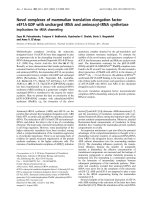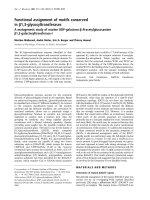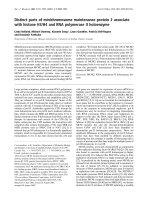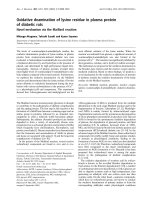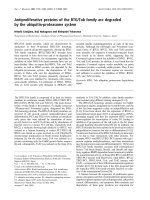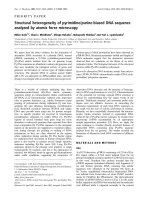Báo cáo y học: " Interrelated modulation of endothelial function in Behcet''''s disease by clinical activity and corticosteroid treatmen" ppt
Bạn đang xem bản rút gọn của tài liệu. Xem và tải ngay bản đầy đủ của tài liệu tại đây (185.99 KB, 6 trang )
Open Access
Available online />Page 1 of 6
(page number not for citation purposes)
Vol 9 No 5
Research article
Interrelated modulation of endothelial function in Behcet's
disease by clinical activity and corticosteroid treatment
Athanase D Protogerou
1
, Petros P Sfikakis
2
, Kimon S Stamatelopoulos
1
, Christos Papamichael
1
,
Kostas Aznaouridis
1
, Emmanuil Karatzis
1
, Theodore G Papaioannou
1
, Ignatios Ikonomidis
3
,
Phedon Kaklamanis
2
, Myron Mavrikakis
1
and John Lekakis
3
1
Vascular Laboratory, Department of Clinical Therapeutics, Alexandra Hospital, Medical School, University of Athens, V. Sofias,115 28, Athens,
Greece
2
1st Department of Propeudeutic and Internal Medicine, Laikon Hospital, Medical School, University of Athens, Ag. Thoma, 115 27, Athens, Greece
3
2nd Department of Cardiology, Attikon Hospital, Medical School, University of Athens, Rimini, 124 61, Athens, Greece
Corresponding author: Athanase D Protogerou,
Received: 30 Apr 2007 Revisions requested: 11 Jun 2007 Revisions received: 18 Jul 2007 Accepted: 11 Sep 2007 Published: 11 Sep 2007
Arthritis Research & Therapy 2007, 9:R90 (doi:10.1186/ar2289)
This article is online at: />© 2007 Protogerou et al.; licensee BioMed Central Ltd.
This is an open access article distributed under the terms of the Creative Commons Attribution License ( />),
which permits unrestricted use, distribution, and reproduction in any medium, provided the original work is properly cited.
Abstract
Corticosteroids are commonly used in empirical treatment of
Behçet's disease (BD), a systemic inflammatory condition
associated with reversible endothelial dysfunction. In the
present study we aimed to dissect the effects of clinical disease
activity and chronic or short-term corticosteroid treatment on
endothelial function in patients with BD. In a case-control, cross-
sectional study, we assessed endothelial function by
endothelium dependent flow mediated dilatation (FMD) at the
brachial artery of 87 patients, who either were or were not
receiving chronic corticosteroid treatment, and exhibiting
variable clinical disease activity. Healthy individuals matched for
age and sex served as controls. Endothelial function was also
assessed in a prospective study of 11 patients before and after
7 days of treatment with prednisolone given at disease relapse
(20 mg/day). In the cross-sectional component of the study,
FMD was lower in patients than in control individuals (mean ±
standard error: 4.1 ± 0.4% versus 5.7 ± 0.2%, P = 0.003),
whereas there was a significant interaction between the effects
of corticosteroids and disease activity on endothelial function (P
= 0.014, two-factor analysis of variance). Among patients with
inactive BD, those who were not treated with corticosteroids (n
= 33) had FMD comparable to that in healthy control individuals,
whereas those treated with corticosteroids (n = 15) had
impaired endothelial function (P = 0.023 versus the respective
control subgroup). In contrast, among patients with active BD,
those who were not treated with corticosteroids (n = 20) had
lower FMD than control individuals (P = 0.007), but in those
who were receiving corticosteroids (n = 19) the FMD values
were comparable to those in control individuals. Moreover, FMD
was significantly improved after 7 days of prednisolone
administration (3.7 ± 0.9% versus 7.6 ± 1.4%, P = 0.027).
Taken together, these results imply that although corticosteroid
treatment may impair endothelial function per se during the
remission phase of the inflammatory process, it restores
endothelial dysfunction during active BD by counteracting the
harmful effects of relapsing inflammation.
Introduction
Behçet's disease (BD) is a relapsing systemic inflammatory
condition of unknown aetiology that is more prevalent in cer-
tain geographical areas and particular ethnic groups [1,2].
Multiple immunological abnormalities, which are possibly
induced by microbial antigens in genetically susceptible indi-
viduals, appear to be important in the pathogenesisof BD.
Such abnormalities are related to the enhanced inflammatory
response observed in these patients, and endothelial activa-
tion and injury and the resultant occlusive vasculopathy may
also contribute to the tissue damage [2]. Large vessel involve-
ment is common [3], and vascular complications are among
the leading causes of increased morbidity and mortality [4].
Although the optimal treatment of these complications is sub-
ject to debate, the current empirical approach includes high
doses of corticosteroids [5]. Early identification of those
patients who are at high risk for developing severe vasculopa-
thy and in need of aggressive treatment remains difficult, and
ANOVA = analysis of variance; BD = Behçet's disease; FMD = flow mediated dilatation; NMD = nitrate mediated dilatation.
Arthritis Research & Therapy Vol 9 No 5 Protogerou et al.
Page 2 of 6
(page number not for citation purposes)
development of means to achieve early identification is a great
challenge in this area.
Multiple lines of evidence indicate that surrogate vascular
markers, such as endothelium dependent flow mediated dila-
tation (FMD), arterial stiffness and arterial wall thickness, are
strong predictors of cardiovascular risk in various cardiovascu-
lar conditions. We and others have previously shown that
endothelial function, assessed noninvasively by high resolution
ultrasound, is impaired in patients with BD [6-9]. Although
inflammation is a well described modulator of endothelial func-
tion [10] and is the target of corticosteroid treatment, which is
commonly used in the management of various manifestations
of BD [1,3,5], little is known about the effects of corticosteroid
treatment on endothelial function in patients with chronic
inflammatory diseases. Interestingly, administration of corti-
costeroids improves endothelial function in patients with giant
cell arteritis, which is the most common primary vasculitic dis-
ease [11]. Conversely, corticosteroids may exert detrimental
effects on endothelial function in the absence of an inflamma-
tory condition [12,13].
The present study was conducted, using both case-controlled
cross-sectional and prospective interventional approaches, to
dissect the effects of clinical disease activity and chronic or
short-term corticosteroid treatment on endothelial function in
patients with BD.
Materials and methods
Cross-sectional, case-control study
Consecutive patients, who were regularly examined in our clin-
ics and had an established diagnosis of BD (according to the
International Study Group criteria [12]), were referred to the
vascular laboratory within 3 to 5 days after they had their last
clinical evaluation to determine clinical disease status. Exclu-
sion criteria included diabetes mellitus, concomitant infection
and treatment with anti-tumour necrosis factor agents. From a
total of 87 referred patients (aged 17 to 71 years) 39 were
classified as having active disease, defined by the presence of
more than two clinical characteristics, including the following
[14]: oral ulcers, genital ulcers, erythema nodosum, pseudo-
phollicullitis and ocular lesions. On the day of the vascular
studies, patients with active BD were receiving no treatment (n
= 3), corticosteroids (mean dose equivalent to 20 mg/day; n
= 19), azathioprine (n = 6), cyclosporine A (n = 4), or colch-
icines (n = 23), or a combination of these agents. Any sug-
gested drug modifications at their last clinical evaluation had
been immediately adopted (3 to 5 days before the vascular
studies). The remaining patients were classified as having sta-
ble or inactive disease (n = 48), receiving steady medication
for at least 1 month (corticosteroids equivalent to 2.5 to 7.5
mg/day, n = 15; azathioprine, n = 7; cyclosporine A, n = 8; col-
chicine, n = 24). The control group included 87 healthy indi-
viduals, matched for age and sex, who were studied in parallel.
None of the patients or control individuals had a history of
stroke or coronary heart disease.
Prospective interventional study
Eleven of the 87 patients described above (five were male;
age 33 to 54 years) who presented at disease relapse while
not receiving corticosteroid treatment were studied prospec-
tively. Subsequent to their clinical assessment, these patients
underwent vascular studies (day 0) and they were prescribed
a daily regimen of 20 mg prednisolone (according to standard
clinical practice for disease relapse), in addition to concomi-
tant treatment, which remained unchanged during the 7 fol-
lowing days. Clinical assessment and vascular studies were
repeated on day 7.
Brachial artery reactivity
Endothelial function was studied, noninvasively, by means of
brachial artery FMD, as described previously [15]. Patients
and control individuals abstained from consumption of
tobacco, coffee, alcohol, antioxidant-containing beverages
and medications for 8 hours before the vascular studies, which
were always performed during the morning. Premenopausal
women were examined during any day of their menstrual cycle
except from the M phase. A high-resolution ultrasound system
(7.0 MHz; Accuson 128XP/10, Accuson, Mountain View, CA,
USA) was used. In brief, after 10 min of rest in a supine posi-
tion in a quiet, temperature controlled room (21°C to 23°C),
the brachial artery was scanned longitudinally and its diameter
at end-diastole (from the inner border line of adventitia to
adventitia) was measured. Subsequently, 5 min of ischaemia
was induced by an inflated cuff (250 mmHg), fitted at 8 cm
distal to the brachial artery, near the wrist. During reactive
hyperaemia (60 to 90 s after cuff deflation) the vessel's maxi-
mal diameter, at exactly the same anatomical site, was meas-
ured. FMD was then calculated as the percentage increase in
diameter from baseline. After 10 min, a second scan at rest
was performed and then nitroglycerin was administered (400
μg sublingual); 5 min later a final scan was taken in order to
assess nitrate mediated dilatation (NMD), which was used as
an index of endothelium independent vasodilatation, in order to
test the functional status of the arterial wall smooth muscle.
All participants gave informed consent and the protocol was
approved by the Alexandra Hospital's research ethics
committee.
Statistical analysis
Statistical analyses were performed using SPSS (13.0 ver-
sion; SPSS Inc., Chicago, IL, USA). χ
2
tests were used to
compare qualitative variables between groups. All of the quan-
titative variables had a normal distribution curve. In the cross-
sectional study analysis of variance (ANOVA), provided by the
general linear model, was applied to the comparison of mean
values between subgroups. Analysis by t-test was applied for
pair-wise comparisons, when appropriate. Two-factor ANOVA
Available online />Page 3 of 6
(page number not for citation purposes)
was also used in the cross-sectional study to investigate the
presence of potential interaction between the presence of
active disease (as defined above) and corticosteroid treatment
(activity × corticosteroids) on FMD. In the prospective study,
because of the limited number of patients, nonparametric anal-
ysis for two related samples (Wilkoxon test) was used to com-
pare changes in FMD and NMD, before and after 7 days on
corticosteroid treatment. Values are expressed as mean ±
standard error of the mean. P < 0.05 was deemed to indicate
statistical significance.
Results
Effects of disease activity and corticosteroid treatment
on endothelial function
There were no significant differences in cardiovascular risk
factors known to affect endothelial function between healthy
control individuals (mean values shown in Table 1) and
patients with BD (n = 87; data not shown for the whole group),
except for body mass index (P < 0.05), which was higher in the
control group. Endothelium dependent FMD was lower in
patients than in control individuals (4.1 ± 0.4% versus 5.7 ±
0.4%, respectively; P = 0.003), whereas endothelium inde-
pendent NMD was similar between groups (12.8 ± 0.5% ver-
sus 13.4 ± 0.7%; not significant). Adjustment for body mass
index did not modify these results.
FMD was similar between patients receiving corticosteroids (n
= 34; 4.3 ± 0.6%) and patients not receiving corticosteroids
(n = 53; 4.0 ± 0.5%). Patients with active BD (n = 39) had
higher FMD than did patients with inactive BD (n = 48; 4.5 ±
0.6% versus 3.8 ± 0.6%, respectively), although this did not
reach statistical significance. Two-factor ANOVA revealed a
significant interaction between the effect of corticosteroids
and disease activity on endothelial function (P = 0.014). These
results were unchanged following adjustment for cardiovascu-
lar risk factors and after excluding those patients who were
receiving treatment with cyclosporine A and azathioprine (data
not shown).
Subsequently, FMD was analyzed among the four subgroups
of patients defined by the presence of active or stable/inactive
disease and the receipt or nonreceipt of corticosteroid treat-
ment, as compared with the FMD in respective matched con-
trol subgroups (Figure 1). Although specific matching for
cardiovascular risk factors (including history of hypertension
and smoking) was not performed, no significant differences
were found in those parameters between control subgroups
(data not shown) and patient subgroups (Table 1). ANOVA
revealed that among patients not receiving corticosteroid
treatment, and in comparison with the control subgroups,
FMD was low in those with stable or inactive disease and even
lower in those with active disease (P = 0.006). Further analy-
sis revealed a significant difference only between patients with
active BD and the control subgroup (P = 0.007; Figure 1a).
However, among corticosteroid-treated patients, FMD was
comparable to that in control individual when only those with
active disease were considered, but it was lower than that in
control individuals when only those with stable/inactive dis-
ease were considered (P < 0.04, ANOVA). Further pair-wise
comparisons revealed significant differences only between
patients with stable/inactive BD and the control subgroup (P
= 0.023; Figure 1b).
Table 1
Cardiovascular risk factors
Control individuals (n = 87) Corticosteroids (-) Corticosteroids (+)
Active BD (n = 20) Stable or inactive BD (n = 33) Active BD (n = 19) Stable or inactive BD (n = 15)
Males/females (n) 58/32 13/7 22/11 14/5 9/6
Age (years) 40.1 ± 1.2 40.9 ± 2.5 40.6 ± 1.5 38.4 ± 2.5 37.6 ± 2.9
Hypertension (n [%]) 13 (14.9) 2 (10.1) 3 (9.4) 5 (26.3) 3 (20.0)
Smokers (n [%]) 40 (46) 12 (60.0) 18 (54.4) 13 (68.4) 5 (33.3)
BMI (kg/m
2
) 27.2 ± 0.7 23.5 ± 1.3 25.2 ± 0.6 24.7 ± 1.0 23.4 ± 1.1
Total cholesterol (mg/dl) 193.2 ± 5.3 200.7 ± 16.0 202.7 ± 8.3 209.6 ± 14.1 215.4 ± 12.2
LDL-cholesterol (mg/dl) 132.4 ± 4.5 120.1 ± 15.1 132.2 ± 7.8 134.6 ± 4.9 143.5 ± 11.2
HDL-cholesterol (mg/dl) 47.7 ± 1.4 44.7 ± 5.5 46.8 ± 2.5 52.1 ± 4.5 52.4 ± 4.1
Triglycerides (mg/dl) 106.6 ± 9.9 115.5 ± 32.2 124.1 ± 12.5 133.2 ± 25.3 125.4 ± 22.8
Glucose (mg/dl) 85.3 ± 1.5 94.1 ± 4.4 91.3 ± 2.0 89.9 ± 3.7 84.5 ± 3.5
Shown are cardiovascular risk factors in control individuals and in patients with Behçet's disease (BD) divided according to the receipt (+) or nonreceipt (-) of
corticosteroid treatment and the clinical disease status. Unless otherwise stated, values are expressed as mean ± standard error. BMI, body mass index; HDL, high-
density lipoprotein; LDL, low-density lipoprotein.
Arthritis Research & Therapy Vol 9 No 5 Protogerou et al.
Page 4 of 6
(page number not for citation purposes)
Furthermore, Figure 1 shows that among patients receiving
corticosteroids, those with active disease had higher FMD
than did those with inactive disease (5.5 ± 1.0% versus 2.7 ±
0.7%; P = 0.034). Those patients with active disease receiv-
ing corticosteroids tended to have higher FMD than did those
not receiving corticosteroids (5.5 ± 1.0% versus 3.4 ± 0.6%;
P = 0.109), whereas those patients with inactive disease on
corticosteroids tended to have lower FMD than did those who
were not receiving corticosteroids (2.7 ± 0.7% versus 4.4 ±
0.6%; P = 0.096).
Regarding NMD, no differences were found between active
and inactive BD or between corticosteroid receiving and non-
receiving patients, and no interaction between corticosteroids
and BD disease was identified (data not shown).
Short-term prednisolone treatment upon relapse
improves endothelial function
Eleven patients of those who were not treated with corticos-
teroids were studied upon disease relapse (signs of relapse:
oral ulcers, n = 9; erythema nodosum, n = 7; venous thrombo-
sis, n = 2; genital ulcers, n = 2; arthritis, n = 4, and central
nervous system involvement, n = 1), as well as after 7 days of
administration of prednisolone (20 mg/day). As shown in Fig-
ure 2 endothelial function improved from days 0 to 7 in eight
patients and remained unchanged or decreased in the three
remaining patients. Endothelium dependent FMD increased
significantly from days 0 to 7 (3.7 ± 0.9% versus 7.6 ± 1.4%;
P = 0.027), whereas endothelium independent dilatation, as
assessed by considering NMD, was not significantly affected
(15.2 ± 1.2% versus 16.4 ± 1.1%; not significant). All patients
had a partial remission of their symptoms at day 7.
Discussion
The main finding of the cross-sectional observational study
was that endothelial function in patients with BD is modulated
by both clinical disease activity and use of corticosteroids,
albeit in an interrelated manner. Because the degree of inflam-
mation cannot safely be assessed in BD using surrogate mark-
ers, such as serum C-reactive protein levels (which do not
correlate with the clinical activity [1]), disease status was
assessed by clinical means only. Endothelial dysfunction was
assessed by a widely-used, reproducible and non-invasive
method, i.e. the FMD at a medium-size conduit artery. FMD is
considered by definition as a reversible disturbance and it is an
independent predictor of cardiovascular events [15]. FMD has
been proved to be mainly induced by production of nitric oxide
from endothelial cells [15], and higher values correlate with
better functional status of the endothelium. It was previously
shown that low-grade, acute inflammatory response, such as
the response induced by Salmonella typhi vaccine, may lead
to a significant detrimental effect on endothelial function
(FMD), albeit one that is reversible [10]. More recent data
demonstrated that short-term systemic inflammation, induced
by intensive periodontal treatment, resulted in acute endothe-
lial dysfunction (FMD), although this was reversible by 6
months after therapy [16]. Finally, in a small group of patients
with active BD, endothelial function was improved by short-
term administration of antioxidants [6]. This further implies that
there exists a connection between inflammation, oxidative
stress and endothelial function [17,18], at least in the acute
Figure 1
Endothelial function in patients with BD and control individuals (cross sectional study)Endothelial function in patients with BD and control individuals (cross
sectional study). Shown is endothelium-dependent flow mediated dila-
tation (FMD) at the brachial artery in subgroups of patients with active
or inactive Behçet's disease (BD) subdivided according to (a) absence
or (b) presence of corticosteroid treatment, and their respective control
subgroups. Numbers of patients and significant differences between
subgroups (t-test) are shown. Values are expressed as mean ± stand-
ard error.
Figure 2
Endothelial function in patients with BD (prospective study)Endothelial function in patients with BD (prospective study). Shown are
changes in endothelium dependent flow mediated dilatation (FMD) at
the brachial artery, in 11 patients with Behçet's disease (BD), before
and after 7 days of treatment with prednisolone (20 mg/day).
Available online />Page 5 of 6
(page number not for citation purposes)
inflammatory phase, which may be associated with the ability
of glucocorticoids to modulate nitric oxide synthase produc-
tion [18].
By studying a large group of patients and control individuals
with comparable cardiovascular risk, a significant effect of BD
disease activity and corticosteroid treatment on endothelial
function was indeed identified. It was also shown that these
results were not modified by the presence of other immuno-
suppressive drugs. Taken together with the presence of the
significant interaction between BD activity and corticosteroid
treatment, the results obtained in the cross-sectional part of
the study suggest that in the presence of higher levels of sys-
temic inflammation endothelial dysfunction may be prevented
by corticosteroid treatment. Moreover, the results of the pro-
spective interventional study showed that the endothelial func-
tion was improved after treatment with 20 mg/day
prednisolone given at disease relapse. A similarly beneficial
corticosteroid-induced effect during the inflammatory phase
has also been observed in patients with newly diagnosed giant
cell arteritis [11]. Endothelium independent mechanisms did
not account for our findings, because NMD was unaffected by
clinical activity of BD or corticosteroid treatment in either the
cross-sectional or the prospective study. These results might
partly explain the beneficial effects of corticosteroids on vas-
cular complications in patients with BD [3,5]. Whether the
level of endothelial dysfunction (as indicated by FMD) in indi-
vidual patients may predict future adverse vascular events in
BD requires further investigation.
On the other hand, the results of the case-control cross-sec-
tional study imply that the chronic use of corticosteroids may
impair endothelial function in patients with stable or inactive
disease and thus lower inflammatory burden. As previously
described in healthy individuals, corticosteroid use may induce
an unfavourable effect on endothelial function in the absence
of systemic inflammation [13]. Increased oxidative stress and
endothelial dysfunction have been described in patients with
endogenous hypercortisolaemia in the absence of a concomi-
tant inflammatory process [12]. This effect may be attributed
to decreased stability of the nitric oxide synthase, increased
oxidative stress, or increased endothelin-1 production
[12,19,20]. The presence of and the role played by endothelial
dysfunction in the atherosclerotic process, as well as its
reversibility, have been confirmed in various clinical settings,
including systemic vasculitis, rheumatoid arthritis, systemic
lupus erythematosous and systemic sclerosis [21-25]. How-
ever, the optimal dose and duration of corticosteroid treatment
with respect to endothelial function related effects are not
known.
Conclusion
The findings presented here suggest that corticosteroids have
a bipolar effect on endothelial function in BD depending on the
level of inflammatory burden. Whether endothelial function
during the remission phase of the inflammatory process may
deteriorate with chronic corticosteroid use has not previously
been addressed and should be confirmed in a prospective
manner. Such studies should also address the question of
potential dose-effect differences of corticosteroid treatment
with respect to endothelial function, because the mean dose
of corticosteroids used in the inactive patients in the cross-
sectional study was considerably less than that used among
the patients with active BD, both in the cross-sectional and in
the prospective parts of our study. Nevertheless, the study
shows that corticosteroid treatment, which is commonly pre-
scribed in acute relapses of BD and especially for complica-
tions that involve the large vessels [3-5], may restore
endothelial dysfunction by counteracting the harmful effects of
relapsing inflammation.
Competing interests
The authors declare that they have no competing interests.
Authors' contributions
ADP conceived of the study, participated in its design and
wrote the manuscript. PPS participated in designing the study
and helped to revise the manuscript. KSS performed haemo-
dynamic measurements. CP participated in sequence align-
ment and drafted the manuscript. KA performed
haemodynamic measurements. EK drafted the manuscript.
TGP performed the statistical analysis. II drafted the manu-
script. PK participated in designing the study and helped to
revise the manuscript. MM participated in designing the study
and helped to revise the manuscript. JL participated in design-
ing the study and helped to revise the manuscript. All authors
read and approved the final manuscript, and made substantial
contributions to it.
References
1. Yazici H: Behçet's syndrome. In Oxford Textbook of Rheumatol-
ogy Edited by: Madisson PJ, Isenberg DA, Wood P, Glass DN.
Oxford Medical Publications, London, Engalnd; 1993:884-889.
2. Gul A: Behçet's disease: an update on the pathogenesis. Clin
Exp Rheumatol 2001:S6-S12.
3. Calamia KT, Schrimer M, Melikoglu M: Major vessel involvement
in Behçet disease. Curr Opin Rheumatol 2005, 17:1-8.
4. Kural-Seyahi E, Fresko I, Seyahi N, Ozyzgan Y, Mat C, Hamuryudan
V, Yurdakul S, Yazici H: The long term motrality and morbidity
of Behçet syndrome. A 2-decade outcome survey of 387
patients followed at a dedicated center. Medicine (Baltimore)
2003, 82:60-76.
5. Kaklamani VG, Kaklamanis PG: Treatment of Behçet's disease:
an update. Semin Arthritis Rheum 2001, 30:299-312.
6. Chambers JC, Haskard DO, Kooner JS: Vascular endothelial
function and oxidative stress mechanisms in patients with
Behçet's syndrome. J Am Coll Cardiol 2001, 37:517-520.
7. Protogerou A, Lekakis J, Stamatelopoulos K, Aznaouridis K, Kara-
tzis E, Ikonomidis I, Papamichael Ch, Markomihelakis N, Mavrikakis
M, Kaklamanis PG: Arterial wall characteristics in patients with
Adamantiades-Behçet's disease. Adv Exp Med Biol 2003,
528:399-404.
8. Ozdemir R, Barutcu I, Sezgin AT, Ermis N, Esen AM, Topal E,
Bariskaner E, Ozerol I: Vascular endothelial function and
plasma homocysteine levels in Behçet's disease. Am J Cardiol
2004, 15:522-555.
Arthritis Research & Therapy Vol 9 No 5 Protogerou et al.
Page 6 of 6
(page number not for citation purposes)
9. Kayikçioglu M, Aksu K, Hasdemir C, Keser G, Turgan N, Kultursay
H, Doganavsargil E: Endothelial function in Behçet's disease.
Rheumatol Int 2006, 26:304-308.
10. Blake GJ, Ridker PM: Novel clinical markers of vascular wall
inflammation. Circ Res 2001, 89:763-771.
11. Gonzalez-Juanatey C, Llorca J, Garcia-Porrua C, Sanchez-
Andrade A, Martín J, Gonzalez-Gay MA: Steroid therapy
improves endothelial function in patients with biopsy-proven
giant cell arteritis. J Rheumatol 2006, 33:74-78.
12. Iuchi T, Akaike M, Mitsui T, Ohshima Y, Shintani Y, Azuma H, Mat-
sumoto T: Glucocorticoid excess induces superoxide produc-
tion in vascular endothelial cells and elicits vascular
endothelial dysfunction. Circ Res 2003, 92:81-87.
13. Mangos GJ, Walker BR, Kelly JJ, Lawson JA, Webb DJ, Whitworth
JA: Cortisol inhibits cholinergic vasodilatation in the human
forearm. Am J Hypertens 2000, 13:1155-1160.
14. International Study Group for Behcet's Disease: Criteria for diag-
nosis of Behçet's disease. Lancet 1990, 335:1078.
15. Corretti MC, Anderson TJ, Benjamin EJ, Celermajer D, Charbon-
neau F, Creager MA, Deanfield J, Drexler H, Gerhard-Herman M,
Herrington D, et al.: Guidelines for the ultrasound assessment
of endothelial-dependent flow-mediated vasodilation of the
brachial artery: a report of the International brachial artery
reactivity task force. J Am Coll Cardiol 2002, 39:257-265.
16. Tonetti MS, D'Aiuto F, Nibali L, Donald A, Storry C, Parkar M,
Suvan J, Hingorani AD, Vallance P, Deanfield J: Treatment of per-
iodontitis and endothelial function. N Engl J Med 2007,
356:911-920.
17. Girod JP, Brotman DJ: Does altered glucocorticoid homeosta-
sis increase cardiovascular risk? Cardiovasc Res 2004,
64:217-226.
18. Griendling KK, Sorescu D, Ushio-Fukai M: NAD(P)H oxidase: role
in cardiovascular biology and disease. Circ Res 2000,
86:494-501.
19. Whitworth JA, Schyvens CG, Zhang Y, Mangos GJ, Kelly JJ: Glu-
cocorticoid-induced hypertension: from mouse to man.
Clin
Exp Pharmacol Physiol 2001, 29:993-996.
20. Provencher PH, Villeneuve A, Morin C: Glucocorticoids increase
proendothelin-1 expression in rat aorta. Endocr Res 1998,
24:737-741.
21. Buckley CD, Rainger GE, Nash GB, Raza K: Endothelial cells,
fibroblasts and vasculitis. Rheumatology (Oxford) 2005,
44:860-863.
22. Filer AD, Gardner-Medwin JM, Thambyrajah J, Raza K, Carruthers
DM, Stevens RJ, Liu L, Lowe SE, Townend JN, Bacon PA: Diffuse
endothelial dysfunction is common to ANCA associated sys-
temic vasculitis and polyarteritis nodosa. Ann Rheum Dis
2003, 62:162-167.
23. Hürlimann D, Forster A, Noll G, Enseleit F, Chenevard R, Distler O,
Béchir M, Spieker LE, Neidhart M, Michel BA, et al.: Anti-tumor
necrosis factor-alpha treatment improves endothelial function
in rheumatoid arthritis. Circulation 2002, 106:2184-2187.
24. El-Magadmi M, Bodill H, Ahmad Y, Durrington PN, Mackness M,
Walker M, Bernstein RM, Bruce IN: Systemic lupus erythomato-
sus: an independent risk factor for endothelial dysfunction in
women. Circulation 2004, 110:399-404.
25. Sfikakis PP, Papamichael C, Stamatelopoulos KS, Tousoulis D,
Fragiadaki KG, Katsichti P, Stefanadis C, Mavrikakis M: Improve-
ment of vascular endothelial function by the oral endothelin
receptor antagonist bosentan in patients with systemic
sclerosis. Arthritis Rheum 2007, 56:1985-1993.
